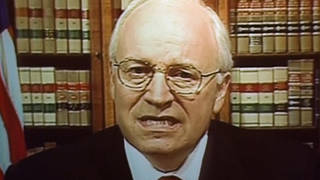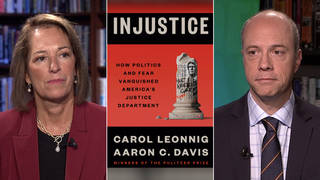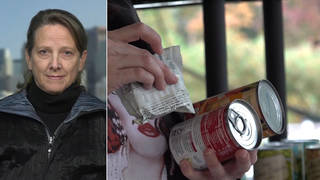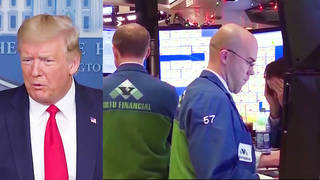
Topics
Guests
- Dean Bakerco-director of the Center for Economic and Policy Research. He is author of several books, his latest being Plunder and Blunder: The Rise and Fall of the Bubble Economy.
One of the key terms to come out of the nation’s economic meltdown has been “too big to fail.” The government has funneled billions of dollars to large financial firms by arguing that their collapse would deal an irreparable blow to economic recovery. A new study has calculated the tab of the “too big to fail” approach, and it amounts to a far larger taxpayer-funded subsidy than previously thought. The Center for Economic and Policy Research says the bailout has allowed “too big to fail” banks to pay significantly lower interest rates than those paid by smaller banks. According to one estimate, that’s meant a subsidy for the nation’s eighteen largest bank holding companies of $34.1 billion a year. That amount represents nearly half these companies’ combined annual profits. We speak to the study’s author, Dean Baker. [includes rush transcript]
Transcript
SHARIF ABDEL KOUDDOUS: One of the key terms to come out of the nation’s economic meltdown has been “too big to fail.” The government has funneled billions of dollars to large financial firms by arguing that their collapse would deal an irreparable blow to economic recovery.
Well, a new study has calculated the tab of the “too big to fail” approach, and it amounts to a far larger taxpayer-funded subsidy than previously thought. The Center for Economic and Policy Research says the bailout has allowed “too big to fail” banks to pay significantly lower interest rates than those paid by smaller banks. According to one estimate, that’s meant a subsidy for the nation’s eighteen largest bank holding companies of $34.1 billion a year. That amount represents nearly half these companies’ combined annual profits.
For more, we’re joined by the study’s co-author, Dean Baker. He’s co-director of the Center for Economic and Policy Research and the author of several books, including his latest, Plunder and Blunder: The Rise and Fall of the Bubble Economy. He also runs the popular economics blog “Beat the Press.” Dean Baker joins us from Washington, DC.
Welcome to Democracy Now! Can you first explain the essential finding of your study?
DEAN BAKER: Well, the basic story is a very simple one. We got data from the Federal Deposit Insurance Corporation on the cost of funds, and they broke out the eighteen largest banks, the ones we looked at, all with assets of more than $100 billion, and compared their cost of funds with all the other banks in the system. And they found that, on average, their cost of funds is about eight-tenths of a percentage point less.
Now, it typically is somewhat less. In other words, the big banks typically pay somewhat less than smaller banks. So what we did was we simply looked at the difference in that difference. So, how much is that gap today, the last three quarters, when we’ve — you know, post-Lehman, when we’ve in fact formalized this “too big to fail” policy, as opposed to what it had been in prior years? And we found there was a very substantial increase in that gap, about half a percentage point, and that comes out to about $34 billion a year in annual subsidies, as you had mentioned. So it’s a pretty sizable interest rate subsidy.
Again, I should qualify this by saying it’s a very crude estimate. I won’t swear that this will hold up through time, but it’s sort of a first effort to take a shot at how large this subsidy is.
SHARIF ABDEL KOUDDOUS: And explain in layman’s terms what you mean by the cost of funds. This is the interest rate that banks pay to attract depositors?
DEAN BAKER: Exactly. So what’s going on, if you or I go down and we deposit $5,000, $10,000, $20,000 in our bank, that’s insured by the FDIC, the federal government, so we could feel pretty safe on that. At least it’s as good as the government.
Now, if we had — let’s say we’re a big investor, we’re a mutual fund, whatever it might be, and we have $10 million to place somewhere. Well, if we go to a small bank, we’re worried. You know, we have to look at them. Are they safe? Are they following good practices? They could go out of business; we would then lose that money. On the other hand, if we go to one of the big banks — a Citigroup, a Bank of America — and we put our $10 million there, we basically know at this point the government is going to come in and bail it out. So we look at that $10 million on deposit with Citigroup or Bank of America almost the same way as we would look as buying a government bond.
SHARIF ABDEL KOUDDOUS: And what are — name the banks that are profiting most from this taxpayer-funded subsidy.
DEAN BAKER: Well, basically, the biggest banks profit the most. You know, so if you look at Citigroup, Bank of America, Wells Fargo — I’m missing one in there of the big four — JPMorgan, the biggest — the bigger the bank, the more you profit. Now, how large is it relative their profits, you have some banks that it amounted the full amount or even more than their profits. Capital One, for example, I believe that actually the subsidy, by our calculation, was actually more than their profits. So it’s — you know, basically the story is, the bigger you are, the more money you pocket. How large that is relative to your profits depends on how profitable the bank would otherwise be.
SHARIF ABDEL KOUDDOUS: Now, this issue of “too big to fail,” many are arguing that the taxpayer-funded bailout created what’s called “moral hazard,” where banks can take excessive risks knowing that they’ll be bailed out if things go wrong. We’ve seen now, a year later, that many of these “too big to fail” banks have become even bigger. They’re still trading in these credit derivatives that are largely unregulated. Are we setting ourselves up for a bigger fall here?
DEAN BAKER: Well, not necessarily a bigger fall. I mean, there was a lot that underlie this, first and foremost, the housing bubble that reached $8 trillion. And we’re not about to reproduce that overnight. But we don’t have — we don’t have a situation in place that will prevent it. And at the very least what we’re having here is, in effect, a subsidy of the large banks at the expense of small banks or smaller banks. Many of the smaller banks are still quite large. But the point is that if you’re a Goldman Sachs, if you’re a Citigroup, you could borrow, and people are happy to lend you money, with the understanding that if things go bad, the government comes in and bails you out.
And Goldman is a great example here, because they’re basically doing exactly what they did before the crisis. That’s explicitly what Lloyd Blankfein, the CEO of Goldman, said. You know, they’re operating the same way. They’re taking risky trades, in some ways more risky than they did previously. Thus far, they’ve paid off. And what that’s meant is they’ve paid big bonuses to — they’re paying big bonuses to their top people. They’re getting, I think it was, $9 billion in bonuses going to their top people this year. But, of course, if they make mistakes, well, we’re on the hook for those mistakes.
SHARIF ABDEL KOUDDOUS: And in your study, you make a comparison of the subsidy provided by this cost of funds difference, and you compare it to things like the grants given to the Temporary Assistance to Needy Families, to foreign aid. What are some of those numbers?
DEAN BAKER: Well, it’s Temporary Assistance for Needy Families. That’s the main welfare program that, you know, people often talk about. That’s around $18 billion. So we’re talking about nearly twice as much going in subsidies to the “too big to fail” banks as go out in the main welfare program from the federal government each year. Foreign aid is around $25 billion. So, again, we’re now talking about somewhere around 30 percent more going to the biggest banks.
So we have a lot of people that will get very upset about money going to foreign aid, money going to needy families, thinking that that might not be a good expenditure, but the point here is we’re giving much more money to Goldman Sachs and Citigroup, Bank of America, than we are to foreign aid or to needy families.
SHARIF ABDEL KOUDDOUS: And is this subsidy essentially keeping some of these banks in business?
DEAN BAKER: Well, it’s hard to say. Certainly, last fall, it was. If, you know, the federal government had just sat there with its arm crossed and just said, “Well, you know, you guys got yourself in trouble, you deal with it,” well, almost certainly Citigroup, Goldman Sachs, Bank of America, many of the others, big ones, would be out of business.
Now, as it stands today, they’ve had a couple profitable quarters. One of the ways, sort of an indirect subsidy — it’s good for the economy, but certainly helps the banks — they could get money at essentially zero interest through the Federal Reserve Board, and then they lend it back to the government. They could buy thirty-year — ten-year bonds at three-and-a-half percent. This has created a situation in which they’re much, much more profitable today. So if we were to somehow convincingly say, you know, “too big to fail” is no longer there, if Citigroup gets in trouble, they’re out of business, I don’t know if, at this point, that would mean they would go out of business. It could. I just — you know, you’d have to look at the books much more closely than I have or probably that we’d have public access to.
SHARIF ABDEL KOUDDOUS: We’re talking to Dean Baker, co-director of the Center for Economic and Policy Research. I want to turn to the issue of jobs. The nation’s official unemployment rate rose to 9.8 percent last month, and the Labor Department said 263,000 jobs were eliminated in September, bringing the total number of workers unemployed to 15 million. I want to turn to some of what President Obama had to say on Friday after the announcement came out. Let’s take a listen.
PRESIDENT BARACK OBAMA: Yesterday’s job report is a sobering reminder that progress comes in fits and starts and that we’re going to need to grind out this recovery, step by step. From the moment I took office, I’ve made the point that employment is often the last thing to come back after a recession. And that’s what history shows us. But our task is to do everything we can possibly do to accelerate that process. And I want to let every single American know that I will not let up until those who are seeking work can find work.
SHARIF ABDEL KOUDDOUS: The Labor Department also announced it had severely underestimated the number of jobs lost between March 2008 and March 2009. The department had originally said about 4.8 million jobs were eliminated during that period, but now officials admit an additional 824,000 jobs were lost. Dean Baker, the significance of this announcement?
DEAN BAKER: Well, what it indicates is that the recession has been much more serious than the official data showed. I should point out, it actually wasn’t a surprise, at least to some of us nerdy types. It was — you know, it’s not that they were tinkering with the books; it’s just the nature of the survey. It was likely that it had underestimated job losses. So this was something that really analysts should not have been surprised by. Analysts specialize in being surprised, it seems. But in any case, it was a predictable result. It means that the downturn was more serious in terms of jobs lost. We’re over seven million down for the cycle to date, if we carry it through to — through the latest numbers through September, which means we’re in a really, really deep hole.
And getting back to what President Obama said, I mean, it’s important to understand, we say that jobs are a lagging indicator, that’s true, but we have a really, really deep hole. And I think there’s this view that somehow because the economy is growing now, which it probably is — I mean, I think we will see growth — that everything’s on the up and up, and it’s sunny days are here again. But I don’t know anyone who projects us to get back to normal levels of unemployment ’til at least 2013, and it could well be 2014 or ’15. We’re looking at a long period of high unemployment, unless we see some very strong measures by the government.
SHARIF ABDEL KOUDDOUS: And the issue of unemployment benefits?
DEAN BAKER: Well, President Obama is proposing to extend them further — and I think that’s a good thing — another thirteen weeks, and also the COBRA, that they would pay 65 percent of people’s health insurance, which, again, is a very, very big thing, because most people unemployed can’t afford their health insurance. So those are big things.
But at the end of the day, we’re — however long we extend the benefits, we’re still going to end up with a lot of people that are unemployed longer than those benefits, because, you know, even if they’re a year and a half, even if they’re two years, we’re looking at high unemployment, as I say, through 2013 and maybe longer. You’re going to have a lot of people that reach the end of those benefits, and it’s not clear what they’re going to have to support themselves
SHARIF ABDEL KOUDDOUS: Dean Baker, I want to thank you very much for being with us. Dean Baker is the co-director of the Center for Economic and Policy Research. He’s author of several books. His latest is Plunder and Blunder: The Rise and Fall of the Bubble Economy. We’ll link to his latest study at democracynow.org.












Media Options